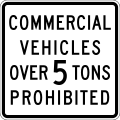Key:goods: Difference between revisions
(common values, based on Taginfo) |
Minh Nguyen (talk | contribs) (→United States: Another diagram) |
||
| (10 intermediate revisions by the same user not shown) | |||
| Line 1: | Line 1: | ||
{{KeyDescription |
{{KeyDescription |
||
|key=goods |
|key=goods |
||
|description=Access permission for goods which are not heavy goods vehicles |
|description=Access permission for goods which are not heavy goods vehicles. |
||
|image=File:Sinnbild_Leichtes_Nutzfahrzeug.svg |
|image=File:Sinnbild_Leichtes_Nutzfahrzeug.svg |
||
|group=Restrictions |
|group=Restrictions |
||
| Line 16: | Line 16: | ||
}} |
}} |
||
Legal access restriction for goods vehicles. |
Legal access restriction for goods vehicles. In most countries, {{Wikipedia|en|light commercial vehicle|light goods vehicles|text=no}} are differentiated from heavy goods vehicles ({{Tag|hgv}}). |
||
== Definitions == |
|||
In most countries, {{Wikipedia|en|light commercial vehicle|light goods vehicles|text=no}} are differentiated from heavy goods vehicles ({{Tag|hgv}}) by their maximum allowed mass being below 3.5 tonnes. |
|||
| ⚫ | |||
=== Europe === |
|||
| ⚫ | |||
In Europe, access tags follow the UNECE Consolidated Resolution on the Construction of Vehicles (R.E.3) on [[w:Vehicle category|vehicle class]]es. {{tag|goods}} corresponds to category N<sub>1</sub>, which is defined as vehicles carrying goods that have at least four wheels and weigh no more than {{convert|3.5|t}}. [https://unece.org/fileadmin/DAM/trans/main/wp29/wp29resolutions/ECE-TRANS-WP.29-78r6e.pdf#page=8] |
|||
=== United States === |
|||
In the United States, {{tag|goods|no}} and {{tag|hgv|no}} are used together, potentially in conjunction with more access tags, wherever a selective exclusion sign refers to "commercial vehicles". Similarly, some street parking signs prohibit use by commercial vehicles. [https://dot.ca.gov/-/media/dot-media/programs/safety-programs/documents/signs/r/r39-a11y.pdf] |
|||
<gallery widths="180"> |
|||
File:MUTCD R5-2.svg|{{tag|hgv|no}} |
|||
File:MUTCD R5-4.svg|{{tag|goods|no}} {{tag|hgv|no}} |
|||
File:MUTCD-CA R36.svg|California:<br>{{tag|maxweight|:=goods||5 st}} {{tag|maxweight|:=tourist_bus||5 st}} {{tag|maxweight|:=coach||5 st}} {{tag|maxweight|:=hgv||5 st}} |
|||
</gallery> |
|||
Each state has laws or standards tying selective exclusion signs to state vehicle classification laws. Some states define specific weight thresholds or vehicle types, while others make reference to the Federal Highway Administration's 13-category classification of motor vehicles. In this classification, {{tag|goods}} may correspond to classes 2 (Passenger Cars) and 3 (Other Two-Axle Four-Tire Single-Unit Vehicles). [https://www.fhwa.dot.gov/policyinformation/tmguide/tmg_2013/vehicle-types.cfm][https://www.fhwa.dot.gov/publications/research/infrastructure/pavements/ltpp/13091/002.cfm][https://www.transportation.ohio.gov/wps/wcm/connect/gov/29b624bc-5956-454f-9270-3e191795da40/SchemeF.pdf?MOD=AJPERES] Even though the U.S. is a UNECE member state, resolution R.E.3 is irrelevant because it only pertains to the ''manufacture'' of vehicles, not their use. |
|||
== Common values == |
== Common values == |
||
Revision as of 05:36, 16 September 2021
| Description |
|---|
| Access permission for goods which are not heavy goods vehicles. |
| Group: Restrictions |
| Used on these elements |
| Useful combination |
|
| See also |
| Status: unsupported “Defacto” status |
| Tools for this tag |
|
[[Category:Key descriptions with status "unsupported “defacto” status"|goods]]
Legal access restriction for goods vehicles. In most countries, ![]() light goods vehicles are differentiated from heavy goods vehicles (hgv=*).
light goods vehicles are differentiated from heavy goods vehicles (hgv=*).
Definitions
Note that not all countries (explicitly) differentiate between light and heavy goods vehicles and some establish a different weight than 3.5 tonnes. See the hgv=* page for more details.
Europe
In Europe, access tags follow the UNECE Consolidated Resolution on the Construction of Vehicles (R.E.3) on vehicle classes. goods=* corresponds to category N1, which is defined as vehicles carrying goods that have at least four wheels and weigh no more than 3.5 tonnes (3.4 long tons; 3.9 short tons). [1]
United States
In the United States, goods=no and hgv=no are used together, potentially in conjunction with more access tags, wherever a selective exclusion sign refers to "commercial vehicles". Similarly, some street parking signs prohibit use by commercial vehicles. [2]
Each state has laws or standards tying selective exclusion signs to state vehicle classification laws. Some states define specific weight thresholds or vehicle types, while others make reference to the Federal Highway Administration's 13-category classification of motor vehicles. In this classification, goods=* may correspond to classes 2 (Passenger Cars) and 3 (Other Two-Axle Four-Tire Single-Unit Vehicles). [3][4][5] Even though the U.S. is a UNECE member state, resolution R.E.3 is irrelevant because it only pertains to the manufacture of vehicles, not their use.
Common values
- yes
- no
- destination
- delivery
- private
- List of possible values with descriptions: see Key:access
- All used values on Taginfo



